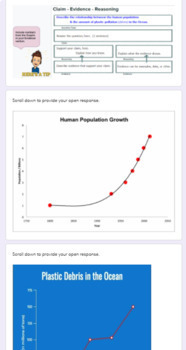Data Analysis: Human Population Increase & Plastic Pollution CER Open Response
- Google Forms™

Description
Students identify the pattern between rising human population & increasing plastic pollution rates. Using line graphs, students are guided in describing the relationship between two data sets to describe the negative human impact on ecosystems.
A claim - evidence- reasoning (CER) graphic organizer is provided to guide students' writing. Encouraged to incorporate evidence, students are also prompted to think about the importance of each element of the CER writing tool. This activity is chunked and guides students to reflect on their thinking.
This Google Form can be shared via Google Classroom, by a link, or printed as a low-tech activity. It is also good for an emergency sub plan.
Like this data analysis activity? Check out other items in my store! =)


